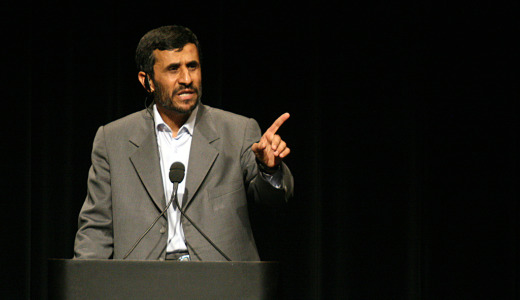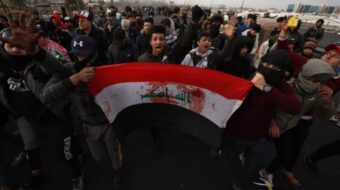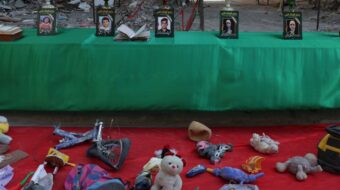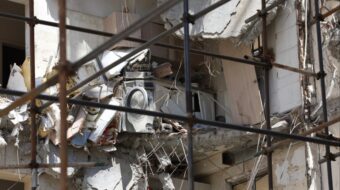
On the first anniversary of the fraudulent election that secured Mahmoud Ahmadinejad’s second term as president, Iran is once again under the international media spotlight. Barely three days after the United Nations Security Council imposed devastating fourth term sanctions on Iran, the fundamentalist regime has clamped down on its seething population and banned the anticipated mass protest demonstrations planned for Saturday June 12, the anniversary of the election. As the world public struggles to balance its total opposition to the UN sanctions and threats of military attack by the U.S. and its allies with its abhorrence of the theocratic dictatorship and the adventurous and ill-thought pronouncements and actions of the Ahmadinejad and his courtiers, this article exposes the true anti-popular roots and intentions of the regime and its continuing impoverishment and subjugation of the Iranian people.
As seen from the outside, Iran’s Islamic regime is superficially characterised by its anti-Western foreign policy and particularly by its verbal attacks against the U.S. and Israel. There is a spectrum of opinion that interprets the regime’s belligerent stance as “anti-imperialist” or rather “anti-American.” However, the vast majority of progressives rightly recognize that beneath its sloganeering facade lies a theocratic and reactionary regime fronted by Ahmadinejad’s illegitimate government. Less noted is the regime’s neo-liberal economic doctrine and its impact on the majority of the population, the working people and the poor.
Since the ending of the Iran-Iraq war in summer 1988, the first peacetime government under Hashemi Rafsanjani, with the support of the spiritual leader (Ayatollah Khamenei), embarked on an IMF-based restructuring of the economy. Rafsanjani’s era, dubbed the “Restructuring Epoch through Economic Adjustment,” was based on the free market mechanisms of privatization, deregulation of the labor market, floatation of the currency and deregulation of prices. This soon left Iran’s economy shattered with 49.5 percent inflation, $34 billion national debt and $22.5 billion trade deficit. At the same time, the rich got richer while the standard of living of the majority of Iran’s population fell massively and structural poverty grew.
In spite of this, neo-liberal economic theory became predominant within various factions of the regime and those in power ignored the mass impoverishment they were creating. Eight years of reformist government, from 1997, led by President Mohammad Khatami, continued on the same damaging neo-liberal path, trying to create investment incentives and a secure climate for private capital in conjunction with deregulation of the labor market. However, increased private sector investment was largely concentrated on non-productive activity, chiefly the import of goods and property speculation, and the free market orientation resulted in more and more painful economic hardship for working people and increased unemployment.
These grave consequences of neo-liberal economics massively discredited the Reformist forces in the eyes of ordinary Iranians and Reformists’ efforts to promote democratic changes and civic society paled into insignificance compared to the deepening poverty suffered by the majority of the people. The Reformists’ unwillingness to confront economic-political corruption and the way in which the rich continued to get richer further fuelled people’s mistrust.
Ahmadinejad, representing one of the most socially reactionary and economically conservative groupings within the regime, was able to capitalize on the adverse and unpopular consequences of the Reformists’ neo-liberal policies and in 2005, backed by the spiritual leader and the “Islamic Guard Corps,” was able to rig the election. At the same time, the Reformists, having lost credibility with the poor and marginalized, were unable to confront the new government.
At the outset, Ahmadinejad’s populist slogans and attacks against the Reformists’ economic plans proved popular among the marginalized and poor and certain disorganized sections of the working people, and his propaganda enabled him to pose as the people’s champion, promising to alleviate chronic poverty, fight corruption and challenge the super-rich. However, it soon became clear that this rogue champion of the people had no intention of reversing the regime’s neo-liberal economic plans. Unrestrained privatization and deregulation of the labor market continued at an even faster pace and workers’ protests were crushed. Behind the smokescreen and his bogus anti-American and anti-corruption ranting, Ahmadinejad intended only to re-brand the regime’s neo-liberal economic orientation, not change it.
Since Ahmadinejad’s first term in office there have been no significant increases in productive investments. The economic growth continues to be based solely on the export of crude oil and a form of parasitic capitalism which is engaged in speculation. The net result has been increasing hardship for working people and the poor. The key difference of Ahmadinejad’s economic program with the one operating before is solely the shifting of the dominant economic beneficiaries within the regime’s elite. His free-market-based economic policies are designed to maximize profit and divert it towards new leading groupings in power.
Given Iran’s under-developed and warped capitalist framework, the adoption of the neo-liberal economic model has been likewise distorted. However, Milton Friedman would have immediately recognized and admired certain fundamentals that are doggedly pursued by Ahmadinejad’s government. Growing privatization of key public assets and the development of a “small government” that shrugs off direct responsibility for national economic development but strictly enforces a non-unionized and cheap labor workforce are examples to note.
What is missing in Iran from Friedman’s neo-liberal model is a totally open competitive market. This is not because of Ahmadinejad’s “anti-capitalist” outlook but because the open market has been deliberately avoided in order to preserve the interest of the oligarchs within the Islamic regime’s ruling circles. The “Islamic Guard Corps” is the key political supporter of Ahmadinejad and its high command has been the main economic beneficiary of the massive privatizations under Ahmadinejad. The Guard’s high command, along with its associated cronies in the regime, is now the powerful and the dominant oligarch in Islamic Iran. It will do anything lawful or unlawful to expand its economic empire, including using intimidation and direct force.
It was during Ahmadinejad’s first term in office that, with the active support of Ayatollah Khamenei, the constitution was amended to require the government to privatize key state assets through Tehran’s Stock Exchange. The lucrative parts of the oil industry, mines and the national telecommunication infrastructure have been the key areas targeted by the commanders of the Islamic Guard. Wherever possible Ahmadinejad’s government has created single-bidder tenders with the Islamic Guard or one of its umbrella organizations as the only contender. To justify this wholesale privatization, Ahmadinejad described it as “giving people’s affairs back to people” and dubbed the privatization as the distribution of “Justice Shares” where ordinary people can become share owners! This is reminiscent of Margaret Thatcher’s “share owning democracy” where, as intended, few shares at all ended up with the people.
In dealing with the government’s economic problems and in particular the growing budget deficit, during the last 12 months Ahmadinejad’s government has embarked on its extremely right-wing “economic shock therapy” which it has dubbed the “great surgery”!
Ahmadinejad’s plans aim to remove all major price subsidies and instead use this money to provide “cash payments” to the disadvantaged. This is one of the main planks of neo-liberal economics advocated by the IMF. This dangerous plan was even opposed by the Parliament that is dominated by the supporters of Ahmadinejad’s rigged election. The legislation had to be forced through with the help of the spiritual leader. All experts are warning that the resulting massive inflationary rise will hurt the working people and the poor. It should be noted that Iran lacks the necessary infrastructures in order to be able to divert the so-called “cash payments” towards those in need.
Ahmadinejad’s government, like its predecessors, sees neo-liberal economics as the remedy to all Iran’s economic problems, while at the same time allowing the regime to protect the economic interests of its elites. Like its predecessors, Ahmadinejad’s government sees the workers of Iran as a dangerous force that needs to be contained in terms of its economic demands, desire to get organized and political activities.
The brutal crackdown by the Islamic Guards on those protesting against the illegal election of Ahmadinejad and continuing imprisonments and executions are not the actions of a state protecting itself against foreign interference. It simply represents the actions of a dictatorship using brute force to protect the political power and massive economic interests of its new oligarchs.
Jamshid Ahmadi is the assistant general secretary of CODIR, Committee for the Defence of the Iranian People’s Rights. For further information on Iran, visit www.codir.net or contact codir_info@btinternet.com.
Photo: http://www.flickr.com/photos/midnightquill/1435157946/ cc 2.0










